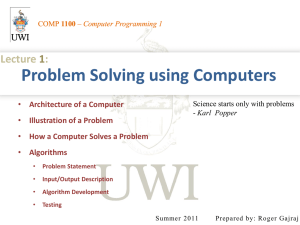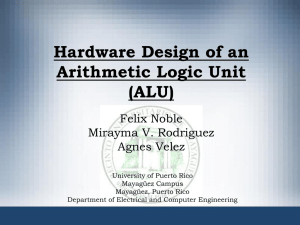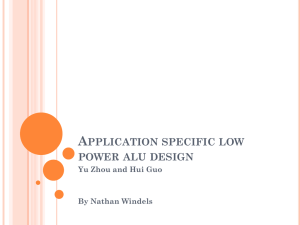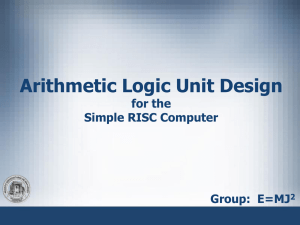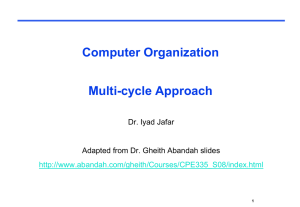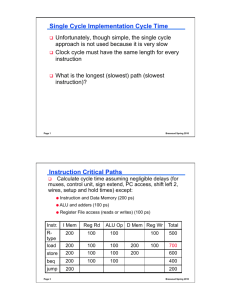Stage 1
advertisement
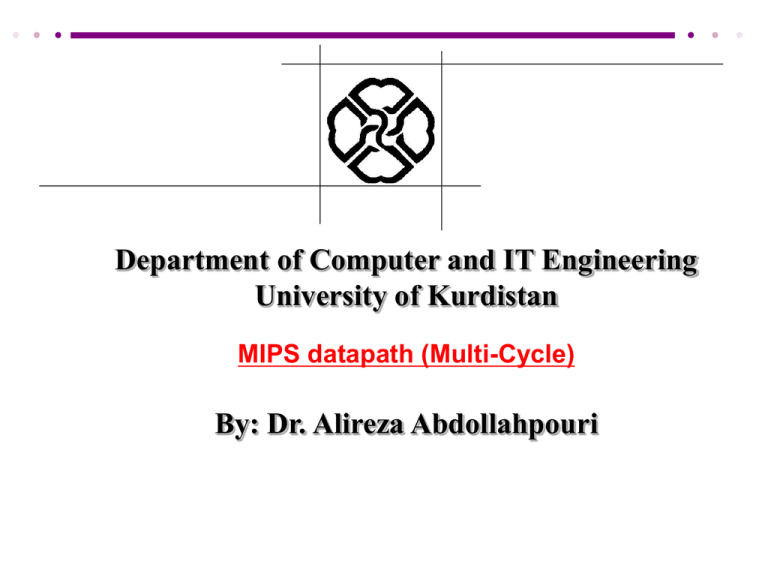
Department of Computer and IT Engineering University of Kurdistan MIPS datapath (Multi-Cycle) By: Dr. Alireza Abdollahpouri A Multi-cycle MIPS processor Any instruction set can be implemented in many different ways MIPS ISA Single Cycle Short CPI Long CCT Multi-Cycle Long CPI Short CCT Pipelined Short CPI Short CCT 2 A Multicycle Implementation Clock Time needed Time allotted Instr 1 Instr 2 Instr 3 Instr 4 Clock Time needed Time allotted Time saved 3 cycles 5 cycles 3 cycles 4 cycles Instr 1 Instr 2 Instr 3 Instr 4 Single-cycle versus multicycle instruction execution. 3 نگرش Multicycle Datapath هر دستور به تعدادی مرحله کوچکتر تقسیم شده و هر یک از این مراحل در یک کالک اجرا میشوند .بدین ترتیب برای اجرای هر دستور به تعدادی کالک کوچک تر نیاز خواهیم داشت. مراحل طوری انتخاب میشوند که کار انجام گرفته در آنها متعادل باشد. در هر مرحله فقط از یکی از بلوک های سخت افزاری اصلی استفاده میشود. هر دستور تعداد متفاوتی کالک الزم دارد. فقط به یک حافظه نیاز دارد .البته در هر سیکل فقط میتوان یکبار به حافظه دسترس ی داشت. فقط به یک ALU/adderنیاز دارد .البته در هر سیکل بیش از یکبار از ALUنمیتوان استفاده نمود. 4 Write Data ALU ALUout Read Addr 1 RegisterRead Read Addr Data 2 1 File Write Addr Read Data 2 Write Data B Address Read Data (Instr. or Data) A IR Memory MDR PC Multicycle Datapath نگرش در این معماری مقادیری که در سیکلهای بعدی دستور مورد نیاز هستند در رجیسترهائی : در نتیجه باید اجزای زیر به معماری افزوده شوند.ذخیره میشوند MDR – Memory Data Register ALUout – ALU output register IR – Instruction Register A, B – regfile read data registers 5 Our new adder setup We can eliminate both extra adders in a multicycle datapath, and instead use just one ALU, with multiplexers to select the proper inputs. A 2-to-1 mux ALUSrcA sets the first ALU input to be the PC or a register. A 4-to-1 mux ALUSrcB selects the second ALU input from among: — the register file (for arithmetic operations), — a constant 4 (to increment the PC), — a sign-extended constant (for effective addresses), and — a sign-extended and shifted constant (for branch targets). This permits a single ALU to perform all of the necessary functions. — Arithmetic operations on two register operands. — Incrementing the PC. — Computing effective addresses for lw and sw. — Adding a sign-extended, shifted offset to (PC + 4) for branches. 6 The multicycle adder setup highlighted PCWrite PC ALUSrcA IorD MemRead 0 RegDst 0 M u x 1 RegWrite M u x Address Read Read register 1 data 1 Memory Write data Mem Data MemWrite 0 M u x 1 Read register 2 Write register Write data 1 Zero Result Read data 2 0 4 1 2 Registers ALUOp 3 ALUSrcB 0 M u x ALU Sign extend Shift left 2 1 MemToReg 7 Eliminating a memory Similarly, we can get by with one unified memory, which will store both program instructions and data. (a Princeton architecture) This memory is used in both the instruction fetch and data access stages, and the address could come from either: the PC register (when we’re fetching an instruction), or the ALU output (for the effective address of a lw or sw). We add another 2-to-1 mux, IorD, to decide whether the memory is being accessed for instructions or for data. 8 The new memory setup highlighted PCWrite PC ALUSrcA IorD MemRead 0 RegDst 0 M u x 1 RegWrite M u x Address Read Read register 1 data 1 Memory Write data Mem Data MemWrite 0 M u x 1 Read register 2 Write register Write data 1 Zero Result Read data 2 0 4 1 2 Registers ALUOp 3 ALUSrcB 0 M u x ALU Sign extend Shift left 2 1 MemToReg 9 Intermediate registers Sometimes we need the output of a functional unit in a later clock cycle during the execution of one instruction. The instruction word fetched in stage 1 determines the destination of the register write in stage 5. The ALU result for an address computation in stage 3 is needed as the memory address for lw or sw in stage 4. These outputs will have to be stored in intermediate registers for future use. Otherwise they would probably be lost by the next clock cycle. The instruction read in stage 1 is saved in Instruction register. Register file outputs from stage 2 are saved in registers A and B. The ALU output will be stored in a register ALUOut. Any data fetched from memory in stage 4 is kept in the Memory data register, also called MDR. 10 The final multicycle datapath PCWrite PC ALUSrcA IorD 0 RegDst 0 M u x 1 RegWrite M u x MemRead Address Memory Write data Mem Data MemWrite IRWrite 0 [31-26] [25-21] [20-16] [15-11] [15-0] Instruction register Memory data register M u x 1 Read Read register 1 data 1 A Read register 2 B Write register Write data Read data 2 4 Registers ALU Zero Result 0 1 2 ALU Out M u x 1 PCSource ALUOp 3 ALUSrcB 0 M u x 1 0 Sign extend Shift left 2 1 MemToReg 11 مسیر داده چند سیکله مسیر داده چند سیکله سه تفاوت عمده با مسیرداده تک سیکله دارد: -1حافظه برنامه و داده ادغام شده است -2تعدادی رجیستر برای ذخیره داده های میانی اضافه شده است -3واحد ALUوظیفه مدارات جمع کننده (برای مقصد پرش و محاسبه آدرس بعدی) را نیز انجام میدهد 12 Multicycle Datapath with Control PCWriteCond PCSource PCWrite Outputs ALUOp IorD ALUSrcB MemRead ALUSrcA Control MemWrite RegWrite MemtoReg Op RegDst IRWrite [5– 0] 0 M 26 Instruction [25– 0] PC 0 M u x 1 Shift left 2 Instruction [31-26] Address Memory MemData Write data Instruction [25– 21] Read register 1 Instruction [20– 16] Read Read register 2 data 1 Registers Write Read register data 2 Instruction [15– 0] Instruction register Instruction [15– 0] Memory data register 0 M Instruction u x [15– 11] 1 B 4 Write data 0 M u x 1 16 Sign extend 32 Shift left 2 1 u x 2 PC [31-28] 0 M u x 1 A 28 Jump address [31-0] Zero ALU ALU result ALUOut 0 1 M u 2 x 3 ALU control Instruction [5– 0] 13 Multicycle control unit The control unit is responsible for producing all of the control signals. Each instruction requires a sequence of control signals, generated over multiple clock cycles. This implies that we need a state machine. The datapath control signals will be outputs of the state machine. Different instructions require different sequences of steps. This implies the instruction word is an input to the state machine. The next state depends upon the exact instruction being executed. After we finish executing one instruction, we’ll have to repeat the entire process again to execute the next instruction. 14 Datapath Control points ... واحد کنترل Multicycle Combinational control logic ... State Reg Next State ... Inst Opcode در معماری Multicycleسیگنالهای کنترل را نمیتوان فقط از روی بیت های دستورالعمل بدست آورد. از اینرو از یک ماشین FSMبرای طراحی واحد کنترل استفاده میشود. تعدادی stateمحدود برای پردازنده فرض میشود که در state regذخیره میشوند. state بعدی از روی stateفعلی ومقادیر ورودی تعیین میشوند. 15 Finite-state machine for the control unit R-type execution Op = R-type Instruction fetch and PC increment ? Register fetch and branch computation Op = BEQ ? ? ? R-type writeback Branch completion ? Memory write Effective address Op = SW computation Op = LW/SW ? ? Memory read Op = LW ? Register write ? Each bubble is a state – Holds the control signals for a single cycle – Note: All instructions do the same things during the first two cycles Stage 1: Instruction Fetch Stage 1 includes two actions which use two separate functional units: the memory and the ALU. Fetch the instruction from memory and store it in IR. IR = Mem[PC] Use the ALU to increment the PC by 4. PC = PC + 4 17 Stage 1: Instruction fetch and PC increment PCWrite IR = Mem[PC] PC IorD ALUSrcA 0 RegDst 0 M u x 1 RegWrite M u x MemRead Address Memory Write data Mem Data MemWrite IRWrite 0 [31-26] [25-21] [20-16] [15-11] [15-0] Instruction register Memory data register M u x 1 Read Read register 1 data 1 A Read register 2 B Write register Write data Read data 2 4 ALU 1 Zero Result 0 1 Registers ALU Out M u x 1 PCSource ALUOp 2 3 ALUSrcB 0 M u x 0 Sign extend Shift left 2 PC = PC + 4 1 MemToReg 18 Stage 1 control signals Instruction fetch: IR = Mem[PC] Signal Value MemRead IorD IRWrite 1 0 1 Description Read from memory Use PC as the memory read address Save memory contents to instruction register Increment the PC: PC = PC + 4 Signal Value ALUSrcA ALUSrcB ALUOp PCWrite PCSource 0 01 ADD 1 0 Description Use PC as the first ALU operand Use constant 4 as the second ALU operand Perform addition Change PC Update PC from the ALU output We’ll assume that all control signals not listed are implicitly set to 0. 19 Finite-state machine for the control unit R-type execution Op = R-type Instruction fetch and PC increment IorD = 0 MemRead = 1 IRWrite = 1 ALUSrcA = 0 ALUSrcB = 01 ALUOp = 010 PCSource = 0 PCWrite = 1 Register fetch and branch computation Op = BEQ ALUSrcA = 0 ALUSrcB = 11 ALUOp = 010 ALUSrcA = 1 ALUSrcB = 00 ALUOp = func R-type writeback RegWrite = 1 RegDst = 1 MemToReg = 0 Branch ALUSrcA = 1 completion ALUSrcB = 00 ALUOp = 110 PCWrite = Zero PCSource = 1 Memory write Effective address Op = SW computation Op = LW/SW MemWrite = 1 IorD = 1 ALUSrcA = 1 ALUSrcB = 10 ALUOp = 010 Memory read Op = LW MemRead = 1 IorD = 1 Register write RegWrite = 1 RegDst = 0 MemToReg = 1 20 Implementing the FSM This can be translated into a state table; here are the first two states. Output (Control signals) Current State Input (Op) Next State PC Writ e Ior D Mem Rea d Mem Write IR Writ e Re g Dst MemT oReg Reg Writ e ALU Src A ALU Src B ALU Op PC Source Instr Fetch X Reg Fetch 1 0 1 0 1 X X 0 0 01 010 0 Reg Fetch BEQ Branch compl 0 X 0 0 0 X X 0 0 11 010 X Reg Fetch Rtype R-type execute 0 X 0 0 0 X X 0 0 11 010 X Reg Fetch LW/S W Compu te eff addr 0 X 0 0 0 X X 0 0 11 010 X You can implement this the hard way (hardwired control). Represent the current state using flip-flops or a register. Find equations for the next state and (control signal) outputs in terms of the current state and input (instruction word). Or you can use the easy way. Write the whole control signals into a memory, like a ROM. This would be much easier, since you don’t have to derive equations. 21 Control Unit (micro-program) اطالعات كنترلي درMicro program در كنترل به صورت .حافظه اي موسوم به حافظه كنترلي ذخیره ميگردد Control Unit CAR CAR: Control Address Register Control memory Control word To DataPath 22 Control Unit (micro-program) CAR 23 Control Unit (micro-program) Microprogram containing 10 microinstructions Label Fetch Mem1 LW2 ALU control Add Add Add Register SRC1 SRC2 control PC 4 PC Extshft Read A Extend Memory Read PC PCWrite control ALU Read ALU Write MDR SW2 Rformat1 Func code Write ALU A B Write ALU BEQ1 JUMP1 Subt A B ALUOut-cond Jump address Dispatch Table 1 Op 000000 000010 000100 100011 101011 Dispatch ROM 1 Opcode name R-format jmp beq lw sw Sequencing Seq Dispatch 1 Dispatch 2 Seq Fetch Fetch Seq Fetch Fetch Fetch Dispatch Table 2 Value Rformat1 JUMP1 BEQ1 Mem1 Mem1 Op 100011 101011 Dispatch ROM 2 Opcode name lw sw Value LW2 SW2 24 حافظه كنترلي (کنترل به روش ریزبرنامه) در کامپیوترهای پیچیده تر حافظه کنترلی ممکن است شامل خانه های تکراری باشد 25 حافظه كنترلي دو سطحی (استفاده از نانو حافظه) اگر در یک سیستم نیاز باشد که تعداد بسیار زیادی سیگنال کنترلی تولید شود و نیز تعداد سیگنالهای کنترلی مجزا محدود و تعداد کمی باشند ،به جای قرار دادن تمامی این سیگنالها در حافظه میکرو ،فقط سیگنالهای مستقل را در یک حافظه تحت عنوان حافظه نانو قرار داده و در حافظه میکرو آدرس این سیگنالها(کلمات) کنترلی را مشخص میکنیم .در این حالت ،ما دیگر تعداد زیاد و تکراری کلمات کنترلی را در حافظه میکرو نداریم و به جای آن آدرسهای تکراری که حافظه کمتری اشغال میکنند را داریم. . 26 مثال 1 مثال 2 حافظه كنترلي دو سطحی (استفاده از نانو حافظه) مثال :فرض کنید که در یک سیستم تعداد 300کلمه کنترلی را داریم .از این 300تا تعداد 60کلمه مستقل هستند( 240تا تکراری هستند) .اگر طول کلمات کنترلی 150بیت باشد(تعداد سیگنالهای کنترلی 150باشد) خواهیم داشت: -1در حالت معمول و بدون استفاده از حافظه نانو ،حجم حافظه میکرو برابر 150*300است. -2در صورت استفاده از حافظه نانو ،حجم این حافظه برابر 150*60است .زیرا در این حافظه فقط قرار است که کلمات کنترلی مستقل و غیر تکراری قرار گیرند. در حالت دوم ،حافظه میکرو فقط باید آدرس 300تا کلمه کنترلی مورد نیاز را از حافظه نانو مشخص نماید .برای مشخص کردن (آدرس دهی) 60کلمه کنترلی ،به 6بیت احتیاج داریم .چون سیستم به 300 سیگنال کنترلی نیاز دارد ،پس در این حالت حجم حافظه میکرو برابر است با.6*300 : میزان صرفه جویی)150*300(-)60*150 + 6*300( = 34200bits : 27 حافظه كنترلي دو سطحی (استفاده از نانو حافظه) یک پردازنده دارای ۱۷۵سیگنال کنترلی و ۲۵۰ریزدستور است .اگر ۲۰۰ریزدستور متفاوت در این پردازنده وجود داشته باشد ،حجم کل حافظه واحد کنترل در صورت استفاده از حافظه نانو چقدر است؟ الف۲۸۰۰۰ -بیت ۳۲۰۰۰بیت ب- ۲۴۰۰۰بیت ج- ۳۷۰۰۰بیت د- 28 Summary A single-cycle CPU has two main disadvantages. The cycle time is limited by the worst case latency. It requires more hardware than necessary. A multicycle processor splits instruction execution into several stages. Instructions only execute as many stages as required. Each stage is relatively simple, so the clock cycle time is reduced. Functional units can be reused on different cycles. We made several modifications to the single-cycle datapath. The two extra adders and one memory were removed. Multiplexers were inserted so the ALU and memory can be used for different purposes in different execution stages. New registers are needed to store intermediate results. 29 Questions 30

